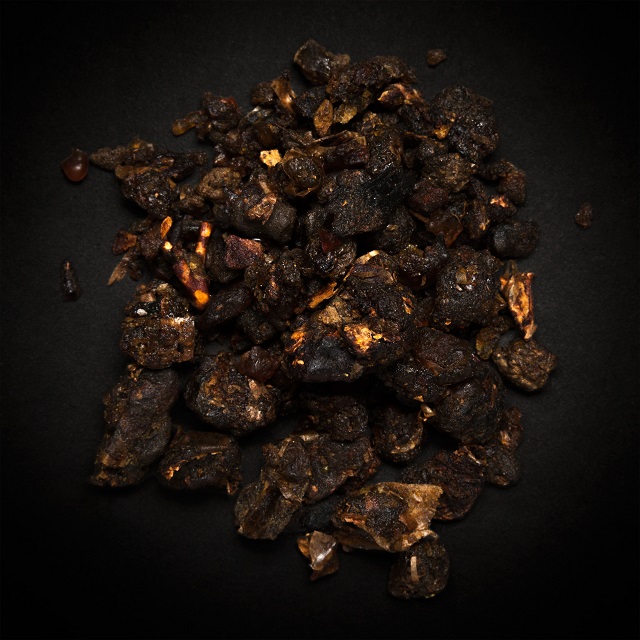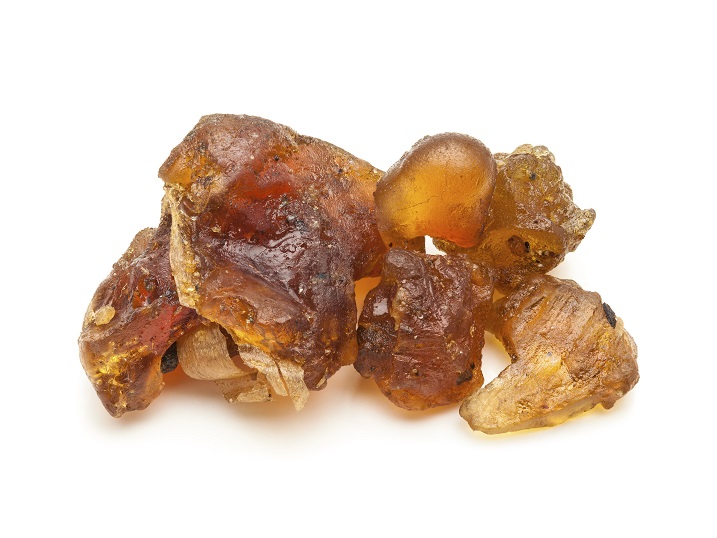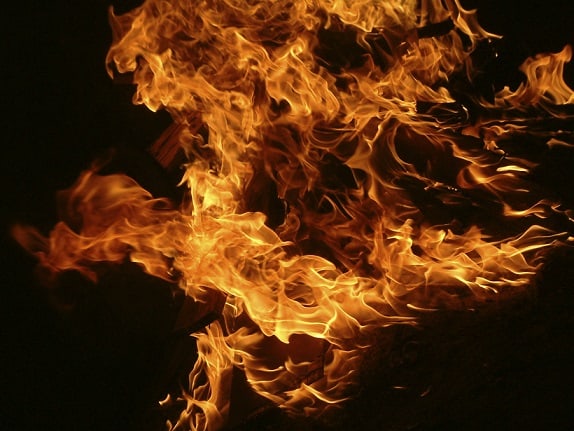Guggul gum is a popular Indian supplement used in ancient Ayurvedic medicine, which has been used since 1000BC at the very least.
The gum originates from the Commiphora wightii plant which grows on rocky, hilly areas, both in India and Pakistan. This is a small thorny tree which is usually leafless, and produces a thick, sticky resin when its branches are damaged. Each guggul plant contains 60 to 100 grams of sappy resin, which is designed to heal its own injury like a natural antiseptic. Guggul gum resin is either used in pure form, or as a standardised extract called gugulipid, which is high in the active medicine compounds: guggulsterones Z and E.
In Sanskrit, guggul translates as “one that protects against diseases”. Guggul is believed to magically treat obesity without even altering your calorie intake. Some Indians believe that burning raw gum over coal to create a thick dense smoke can drive evil spirits away from the household, and remove the “evil eye” from nearby humans.
Most famously, guggul is touted as a natural way to lower cholesterol, which it does by 11.7% according to one study. Other active compounds include muscanone and myrrhanones…
…and the real reason we’re discussing this random sticky resin from India is some excellent studies on acne.
Excellent study one
Our first study on guggul gum was a simple comparison test between the standardised extract, gugulipid, and tetracycline, one of the most common oral antibiotics against acne (which I recommend against). The dosages were gugulipid featuring 25mg of the active guggulsterone compounds, and 500mg of tetracycline, a standard dose.
20 acne patients were gathered, divided into two groups, and ordered to take each supplement twice daily. As the scientists expected, tetracycline led to a 65.2% reduction in total pimple counts after 3 months. What they probably didn’t expect was that guggul gum was even better, with a 68% reduction.
Read Annihilate Your Acne – get the ultimate diet and clear your acne permanently!
Furthermore, 4 out of 10 patients taking tetracycline experienced a relapse 3 months after the study, which you’d expect given that antibiotics also massacre the friendly bacteria on your face. With guggul gum meanwhile, only 2 patients relapsed after 3 months.
Those with the oiliest skin experienced far greater reductions in overall pimple counts. Both treatments “produced a progressive reduction in the lesions in the majority of patients”. The study was conducted in 1994, yet there has been very little research on guggul and acne since then.
Guggul gum, an obscure Asian remedy, somehow managed to beat one of mainstream dermatology’s most widely used and prescribed treatments. A 68% reduction would revolutionise your skin if your acne were severe; you would look like a completely new person.
Excellent study two
Our second study also examined a standardised gugulipid supplement, this time without a comparison. 30 patients with moderate to severe acne were prescribed gugulipid for 6 weeks. The results were as follows: an excellent response in nine (30%), a good response in fourteen (46.66%), and a moderate response in seven (23.33%).
In other words, 30 out of 30 acne patients experienced some benefit. The gugulipid had excellent tolerance and only 3 patients reported a relapse after 3 months of treatment, which shows that the benefits were long lasting even if they probably weren’t permanent (few acne supplements are).
The scientists commented that “gugulipid, a standardized drug of ancient Indian medicine, has a remarkable effect on acne vulgaris“. They also theorised that guggul gum works due to a systematic hypolipidic effect, or in plain English, reducing oil production due to a decrease in excess fats across the whole body.
Recommended – the top 6 vitamins and minerals for acne-free skin
They likely deduced this from guggul gum’s famous cholesterol lowering effect. Secondly, they theorised that guggul inhibited the lipolysis of triglycerides by acne bacteria, essentially when p.acnes digests skin surface fats for its own fuel, which tends to produce inflammatory by-products.
Does guggul gum reduce sebum production?
These two studies are excellent for acne, but overall, mainstream dermatology couldn’t care less about guggul gum. Only 1 follow up study was conducted after the first released 22 years ago. We have no know proof as to how guggul achieves these acne-clearing wonders.
As stated above, the first theory was that guggul gum’s cholesterol-reducing abilities also translate into an oil-reducing effect. The whole cholesterol saga started in the 1960s when Indian archeologists read an ancient Sanskrit text describing the usage of guggul gum to treat a hardening of the arteries. After several positive studies on animals, the gugulipid form was granted approval in June 1986 for marketing as a lipid-lowering drug in India.
Since then, positive studies on humans have released, including one where 61 patients with hypercholesterolemia were given either 50mg of gugulipid or a placebo twice daily. After 24 weeks, the guggul group had 11.7% lower cholesterol, 12.5% lower LDL cholesterol (the artery clogging type) and no change in “good” HDL cholesterol. Another two studies from 1986 and 1989 found that guggul increases HDL, but lowers LDL cholesterol.
The question is whether this translates to reduced sebum (oil), and the answer is probably not. Just because cholesterol is a type of fat does not mean that the effects will be identical.
The top 7 topical treatments for clearing acne naturally
Consider olive oil; eating some on your salad every lunchtime can lower LDL cholesterol. But has anyone ever noticed it reducing sebum output? Eating 3 boiled eggs for breakfast each day can lower LDL cholesterol, but nobody would do that for oily skin (except if you needed the vitamin A). The truth is that this theory is half-baked, there’s no plausible connection.
The reduction in cholesterol is apparently due to the active guggulsterone compounds. These are antagonists of the farnesoid X receptor in the liver, which decreases the liver’s creation of LDL cholesterol. None of this has any connection to your skin’s oil. For example, vitamin A works by binding directly to sebaceous glands and downregulating their activity.
The only real evidence is that acne patients with oily skin enjoyed the biggest reduction from guggul gum, but that could be explained by another factor.
Anti-inflammatory properties may be the answer
Instead of lowering sebum, I believe that the answer to guggul gum’s greatness lies in its anti-inflammatory properties.
There’s endless studies, beginning with an animal experiment where guggul gum equalled the pharmaceutical anti-inflammatory drugs ibuprofen and phenylbutazone. It was also 20% as powerful as hydrocortisone, the default shot a doctor will give you if you have a swollen shoulder from a weight injury or bike crash.
In mice with induced colitis (an inflammatory disease of the colon), guggul gum significantly reduced levels of inflammatory damage (study). The active guggulsterones could also heal rats with uveitis, an inflammatory disease characterized by swelling of the middle layer of the eye (study).
Two additional active compounds in guggul gum resin are myrrhanol A and myrrhanone A, and when tested in isolation, these were equal to hydrocortisone for extinguishing elevated inflammation in mice (study). None of these studies are on acne directly, but chronic inflammation is the same barrage of chemicals that swells a skin pore up to become a pimple.
Why using raw honey could revolutionise your skin
This old 1972 study on arthritis seemed to identify guggulsterone before it was properly discovered. It references a crystalline steroid extracted from guggul gum which inhibited the full development of arthritis lesions in rats, and lessened the severity of secondary inflammatory lesions.
Finally, this study seemed to pinpoint one of guggul gum’s specific mechanisms: lowering NF-kappaB, a master molecule that transcripts and regulates a variety of pro-inflammatory chemicals.
What about the rest of Ayurvedic medicine – do any of the ailments guggul gum was used to treat tell us anything? Some other target illnesses include…
- Weak digestion.
- Menstrual cramps.
- Bone fractures.
- Obesity (probably false).
- High blood pressure.
- Impure blood.
Of those, weak digestion is the most interesting for acne. Malfunctioning digestion can feed into 1) decreased absorption of acne nutrients from food, 2) inflammation due to leaky gut syndrome, and 3) random food sensitivities which cause unexplained pimple outbreaks.
One scripture claims that guggul gum kindles agni, the digestive fire. There are few studies available on digestion, but the one on mice from earlier showed reduced inflammation in the colon.
There’s also evidence that guggul gum resin is a decent source of antioxidants, as the 1994 cholesterol study from earlier observed a 33.3% decrease in overall oxidative stress. That could be a massive reduction in the free radicals floating around your bloodstream.
Guggul gum contains numerous compounds in addition to guggulsterone, myrrhanones, and myrrhanols; there’s diterpenes, lignans, ferulic acid, and more. Many of those have strong antioxidant properties when found in other foods, like coffee.
The verdict – is guggul gum recommended for acne?
Guggul gum is an interesting acne supplement, but for now, its exact powers are a secret.
This yellow coloured tree resin has two promising studies for acne. Neither are conclusive, as a group of 10 is a fairly small sample size, but the group of 30 from the second study was larger. In both cases, the results (68% reduction and excellent improvement in 30%) were very promising.
On the other hand, guggul gum was thought to be the touchstone of cholesterol lowering remedies, but more recent studies have been mixed. This and this study actually found slight increases in “bad” LDL cholesterol. The shocking benefits for acne could also be a smokescreen; guggul gum might be no better than a serving of fruit or vegetables.
For example, if the 10 and 30 acne patients were all highly deficient in antioxidants, then pomegranate or sweet potato could have pushed them back into clear skin territory just as effectively. Guggul gum wouldn’t be unique at all.
Because guggul gum isn’t fully researched and thus could contain some nasty surprises, I won’t officially endorse it, but it definitely beats overrated scams like chlorophyll (claims to purify the blood and liver).
Dosage, and any side effects?
If you decide to take guggul gum, then be sure to follow the proper requirements. The standard dose is two 325mg tablets daily of the supplemental form, equivalent to 75mg of guggulsterones. Others recommend approximately 1000mg of guggul gum per day.
Don’t megadose, since official studies haven’t tested massive doses. Guggul gum should be avoided if you’re pregnant, nursing, taking any medication, especially anticoagulant or antiplatelet medication like warfarin (guggul has anticoagulant properties as well).
As for side effects, digestive discomfort and nausea have sometimes been reported. Generally though, guggul gum resin isn’t especially dangerous, because Indians and some Pakistanis have been using it since at least 1000BC, when it was apparently used for “clearing the coating and obstruction of channels“. One study apparently used a standard guggul gum dose for 75 weeks without problems.
The only real “side effect” is that the c.wightii plant is now critically endangered due to overharvesting. Most gathering is performed by local villagers, whose techniques are pretty inefficient. They often cut the guggul tree’s branches, and then apply horse urine with the goal of keeping the sap flowing, but this just ends up infecting the guggul plant and killing it.
Why grapeseed oil could transform your skin
Usually, local growers of crops have more ancient knowledge and wisdom. But this is one rare instance where corporations are more efficient, with machinery that breaches the plant’s branches with the optimal frequency.
Other endangering factors include desertification, habitat destruction, and the plant not proliferating well in the first place. The guggul tree takes at least seven years to grow to harvestable levels, so replenishing the lost supply takes forever.
The result has been a sharp decline from 1963-1964, when Indian production was a huge 51 metric tons. Luckily, grassroots organisations are now swooping in; they’re educating local growers and harvesters on more efficient tapping techniques, and they aim to establish a safe haven of 1200 to 2000 acres of new guggul plants.
This does give us one final piece of evidence: that Indians and Pakistanis were so convinced of guggul gums’s extraordinary powers that they almost overharvested the species to death.
NEXT: get the complete strategy for clearing acne naturally
Thanks for reading!




Awesome read. I want to personally thank you Richard for all you have done for us.
You know more about acne than the extremely overrated Dermatologist & any other blog.with limited knowledge .
You truly are a blessing to the World and your book is amazing.
I always recommend it to all my friends online & family :) thank you again
Thanks!
Hi
Great article.
I tried guggul powder for acne, I bought the powder online, so i don’t know how pure it was, i had two 1 gram capsules a day. My experience was that it cleared all my body acne, “back,chest, arms,” but it did nothing for my facial acne.
Interesting story. Guggul gum is as mysterious as ever.
Very nice information I want to share that I am a homeopathic physician in India I have prescribed many of my patient guggulu in homeopathic mother tincture form with excellent results.
Hi Richard!! what would be a great supplement for this substance? you mentioned two 325mg tablets daily of the supplemental form, equivalent to 75mg of guggulsterones, but what would it be the best one to get?